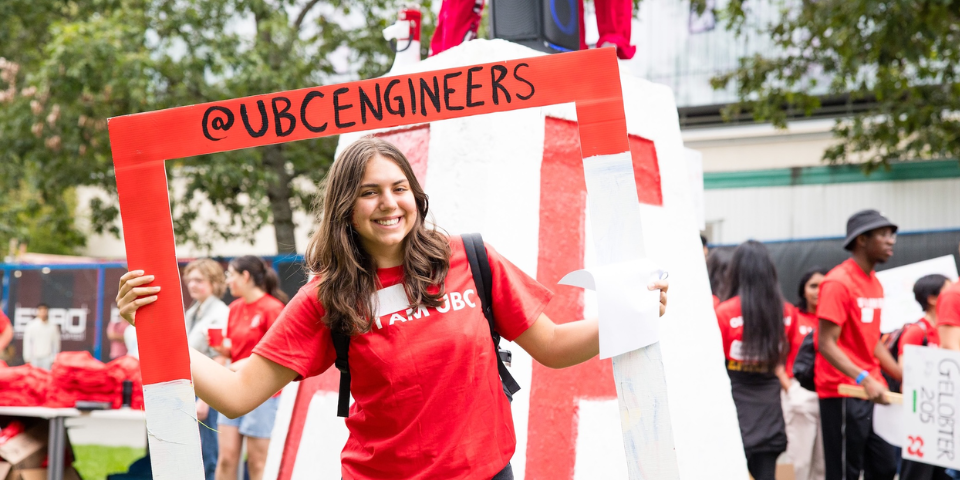The Faculty of Applied Science accepts transfer students from other post-secondary institutions and from other UBC Faculties.
How transfer students are evaluated
Post-secondary transfer students are evaluated based on their most recent 30 credits of university-transferrable courses, though UBC may review your entire academic record, including any failed and repeated courses.
Applicants must also have taken courses in mathematics (calculus), chemistry and physics which transfer to the first-year engineering program and achieve an average of at least 70% in each of these core subject areas. Courses to be considered in this average of first-year transferrable mathematics, chemistry, and physics courses are not limited to the last 30 credits only.
Where two courses, or one repeated course, have been taken which transfer to one of the courses of the first-year engineering program, only the grade of the latest course will be used in calculating the average. Please see the Academic Calendar for all policies on post-secondary transfer.
Admission requirements need to be completed by April 30th of the application year.
Students with less than 24 transferrable credits from a post-secondary institution will be evaluated against both secondary and post-secondary admission criteria.
Transfer to Year 2 and Enter an Engineering Specialization
To be eligible for placement in an engineering specialization, you need to have completed 27 university transferrable credits from our first-year engineering program by the end of April, prior to a September start date. Credits must include transferrable courses in each area of mathematics (calculus), chemistry, and physics with a minimum average of 70% in each subject area. In addition, your overall admissions average will be used for program placement.
Courses taken in the summer, prior to a September start date, will not be considered in your admissions application or eligibility for program placement, but can be considered for transfer credit.
We recommend this route for prospective transfer students, and would be happy to discuss your options further with us at Engineering Academic Services.
Transfer to Year 1 - General First Year
If you have completed less than 27 credits that transfer into the UBC first-year engineering program, you are not eligible for admissions into Year 2 and your application will be evaluated for entry into the first year. Transfer students successfully admitted to the first year will complete a modified first-year program. Students must present post-secondary courses transferrable to the first year in mathematics, chemistry, and physics.
Year 1 admission for transfer students is competitive. We encourage all applicants with strong academic standing to apply.
Transfer credit
Use the BC Transfer Guide to determine how your courses may transfer to UBC credit. Using the course equivalency table below, you can determine how your UBC credit will apply to the first-year engineering curriculum.
Transfer credit will be assessed when your application for admission is processed; you will need to provide a course outline/syllabus once you have been admitted and accepted your offer to Engineering. All transfer credit assessments will be completed after a student has accepted their offer of admission to UBC Engineering. Engineering Academic Services will create and share a personalized transfer credit summary to help you with your registration. We recommend that if you have general transfer credits which have not been predetermined to specific UBC equivalencies, you submit a request for an assessment of your transfer credits, once you have been admitted. For more information about transfer credits, please refer to the Engineering Academic Services website.
Engineering Program Placement
Students who are successfully admitted to Year 2 will go through the program placement process. For newly admitted students, program placement will be based on your admission average and personal statement provided on the program placement form. Please refer to our Engineering Academic Services website for more details about the program placement process.
First-Year Curriculum Course Equivalency
When counting equivalent transfer credit towards the first-year engineering program, please use the credit total in the right-hand column to determine the number of transferrable credits.
| UBC equivalent courses | UBC Engineering First Year courses | Credits |
|---|---|---|
| No equivalent. Complete course once admitted to UBC Engineering. | APSC 100* | 3 |
| No equivalent. Complete course once admitted to UBC Engineering. | APSC 101* | 3 |
| APSC 160 | APSC 160 | 3 |
CHEM 154 Or one of: CHEM 111 (4) and CHEM 113 (4) or; | CHEM 154 Or CHEM 121 and CHEM 123 | 3
6 |
| WRDS 150, ENGL 100, 110, 111, or 112 | WRDS 150** | 3 |
| MATH 100, 102, 104, 120, 180, or 184 | MATH 100 | 3 |
| MATH 101, 103, 105, or 121 | MATH 101** | 3 |
| MATH 221 or 223 | MATH 152** | 3 |
PHYS 117 (3), PHYS 118 (3), and PHYS 119 (1) or; PHYS 131 (3), PHYS 118 (3), and PHYS 119 (1) or; | PHYS 157, PHYS 158 and PHYS 159** | 7 |
| PHYS 170 | PHYS 170** | 3 |
| Humanities and Social Sciences Elective | Humanities and Social Sciences Elective*** | 3 |
* If you have the equivalent of APSC 150, you will not be required to take APSC 100 and APSC 101. If you have the equivalent of APSC 151 AND one of CHEM 111+113 OR CHEM 111+123 OR CHEM 121+123, you will not be required to take APSC 100, APSC 101 and CHEM154.
** Mechanical Engineering at the Vancouver campus, requires specific first-year pre-requisite courses to be completed prior to program placement. For more information, please visit the Mechanical Engineering website for required pre-requisites.
*** Ensure any transferrable Humanities and Social Sciences electives are approved, by checking our Humanities and Social Sciences Requirement website.
How to apply
- New to UBC students: Apply for admission through Education Planner BC - How to Apply
- Current UBC students: Log in to the Application Service Centre and select Re-admission/Change of Degree Program.
More questions?
Contact an Academic Advisor at Engineering Academic Services.
Transfer Student Info Session
For more information about UBC Engineering transfer options at the UBC Okanagan campus: UBC OKANAGAN ENGINEERING TRANSFER OPTIONS




